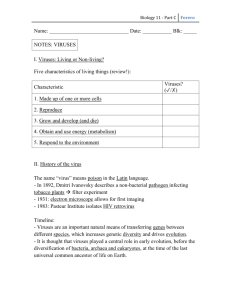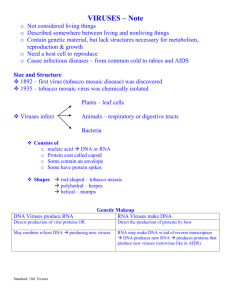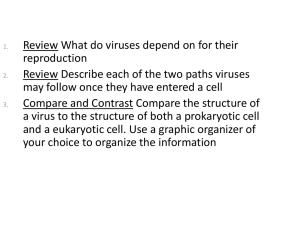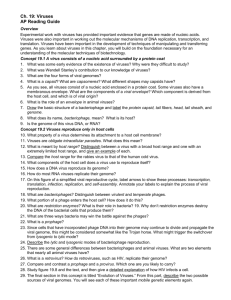Chapter 19 Practice Multiple Choice
advertisement
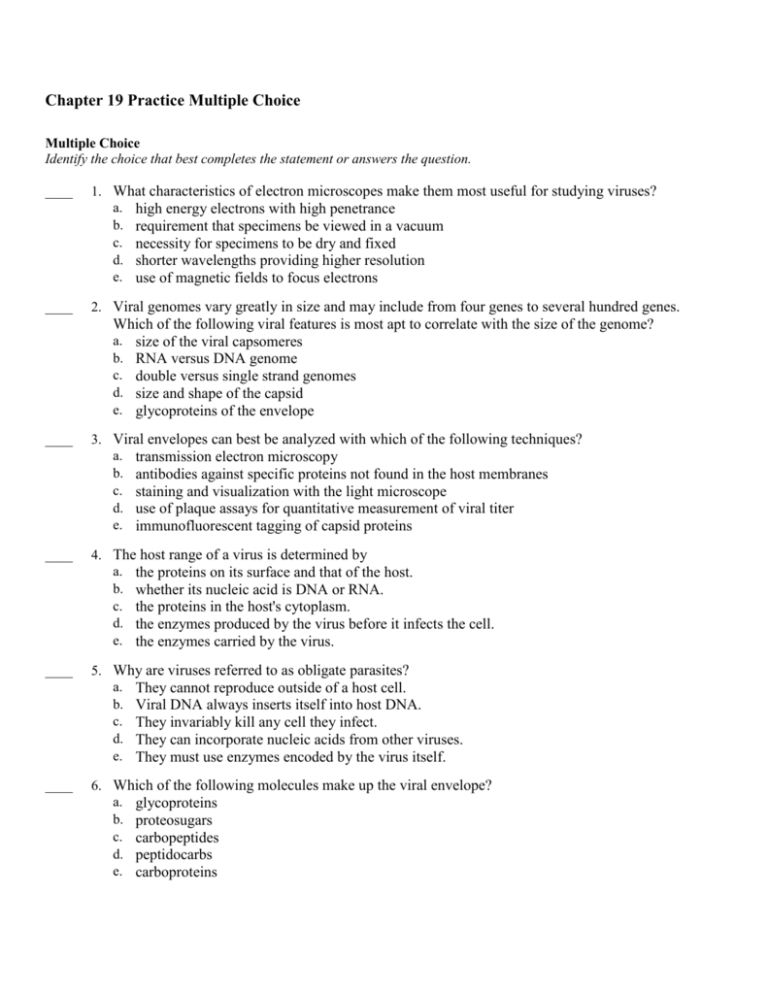
Chapter 19 Practice Multiple Choice Multiple Choice Identify the choice that best completes the statement or answers the question. ____ 1. What characteristics of electron microscopes make them most useful for studying viruses? a. high energy electrons with high penetrance b. requirement that specimens be viewed in a vacuum c. necessity for specimens to be dry and fixed d. shorter wavelengths providing higher resolution e. use of magnetic fields to focus electrons ____ 2. Viral genomes vary greatly in size and may include from four genes to several hundred genes. Which of the following viral features is most apt to correlate with the size of the genome? a. size of the viral capsomeres b. RNA versus DNA genome c. double versus single strand genomes d. size and shape of the capsid e. glycoproteins of the envelope ____ 3. Viral envelopes can best be analyzed with which of the following techniques? a. transmission electron microscopy b. antibodies against specific proteins not found in the host membranes c. staining and visualization with the light microscope d. use of plaque assays for quantitative measurement of viral titer e. immunofluorescent tagging of capsid proteins ____ 4. The host range of a virus is determined by a. the proteins on its surface and that of the host. b. whether its nucleic acid is DNA or RNA. c. the proteins in the host's cytoplasm. d. the enzymes produced by the virus before it infects the cell. e. the enzymes carried by the virus. ____ 5. Why are viruses referred to as obligate parasites? a. They cannot reproduce outside of a host cell. b. Viral DNA always inserts itself into host DNA. c. They invariably kill any cell they infect. d. They can incorporate nucleic acids from other viruses. e. They must use enzymes encoded by the virus itself. ____ 6. Which of the following molecules make up the viral envelope? a. glycoproteins b. proteosugars c. carbopeptides d. peptidocarbs e. carboproteins Use the following information to answer the following questions. In 1971, David Baltimore described a scheme for classifying viruses based on how the virus produces mRNA. The table below shows the results of testing five viruses for nuclease specificity, the ability of the virus to act as an mRNA, and presence (+) or absence (-) of its own viral polymerase. Virus Nuclease A B C D E ____ Sensitivity Dnase Rnase Dnase Rnase Rnase Genome as mRNA + + Polymerase + + - 7. Given Baltimore's scheme, a positive sense single-stranded RNA virus such as the polio virus would be most closely related to which of the following? a. T-series bacteriophages b. retroviruses that require a DNA intermediate c. single-stranded DNA viruses such as herpesviruses d. nonenveloped double-stranded RNA viruses e. linear double-stranded DNA viruses such as adenovirus ____ 8. A linear piece of viral DNA of 8 kb can be cut with either of two restriction enzymes (X and Y). These are subjected to electrophoresis and produce the following bands: Cutting the same 8 kb piece with both enzymes together results in bands at 4.0, 2.5, 1.0, and 0.5. Of the possible arrangements of the sites given below, which one is most likely? a. b. c. d. e. ____ 9. Which of the following accounts for someone who has had a herpesvirus-mediated cold sore or genital sore getting flare-ups for the rest of life? a. re-infection by a closely related herpesvirus of a different strain b. re-infection by the same herpesvirus strain c. co-infection with an unrelated virus that causes the same symptoms d. copies of the herpesvirus genome permanently maintained in host nuclei e. copies of the herpesvirus genome permanently maintained in host cell cytoplasm ____ 10. In many ways, the regulation of the genes of a particular group of viruses will be similar to the regulation of the host genes. Therefore, which of the following would you expect of the genes of the bacteriophage? a. regulation via acetylation of histones b. positive control mechanisms rather than negative c. control of more than one gene in an operon d. reliance on transcription activators e. utilization of eukaryotic polymerases ____ 11. Which of the following terms describes bacteriophage DNA that has become integrated into the host cell chromosome? a. intemperate bacteriophages b. transposons c. prophages d. T-even phages e. plasmids ____ 12. Which of the following statements describes the lysogenic cycle of lambda () phage? a. After infection, the viral genes immediately turn the host cell into a lambdab. c. d. e. producing factory, and the host cell then lyses. Most of the prophage genes are activated by the product of a particular prophage gene. The phage genome replicates along with the host genome. Certain environmental triggers can cause the phage to exit the host genome, switching from the lytic to the lysogenic. The phage DNA is incorporated by crossing over into any nonspecific site on the host cell's DNA. ____ 13. Most molecular biologists think that viruses originated from fragments of cellular nucleic acid. Which of the following observations supports this theory? a. Viruses contain either DNA or RNA. b. Viruses are enclosed in protein capsids rather than plasma membranes. c. Viruses can reproduce only inside host cells. d. Viruses can infect both prokaryotic and eukaryotic cells. e. Viral genomes are usually more similar to the genome of the host cell than to the genomes of viruses that infect other cell types. ____ 14. What is the function of reverse transcriptase in retroviruses? a. It hydrolyzes the host cell's DNA. b. c. d. e. It uses viral RNA as a template for DNA synthesis. It converts host cell RNA into viral DNA. It translates viral RNA into proteins. It uses viral RNA as a template for making complementary RNA strands. ____ 15. Which of the following can be effective in preventing viral infection in humans? a. getting vaccinated b. taking nucleoside analogs that inhibit transcription c. taking antibiotics d. applying antiseptics e. taking vitamins Refer to the treatments listed below to answer the following questions. You isolate an infectious substance that is capable of causing disease in plants, but you do not know whether the infectious agent is a bacterium, virus, viroid, or prion. You have four methods at your disposal that you can use to analyze the substance in order to determine the nature of the infectious agent. I. II. III. IV. treating the substance with nucleases that destroy all nucleic acids and then determining whether it is still infectious filtering the substance to remove all elements smaller than what can be easily seen under a light microscope culturing the substance by itself on nutritive medium, away from any plant cells treating the sample with proteases that digest all proteins and then determining whether it is still infectious ____ 16. Which treatment would you use to determine if the agent is a prion? a. I only b. II only c. III only d. IV only e. either I or IV ____ 17. Which of the following describes plant virus infections? a. They can be controlled by the use of antibiotics. b. They are spread throughout a plant by passing through the plasmodesmata. c. They have little effect on plant growth. d. They are seldom spread by insects. e. They can never be inherited from a parent. ____ 18. Which of the following represents a difference between viruses and viroids? a. Viruses infect many types of cells, whereas viroids infect only prokaryotic cells. b. Viruses have capsids composed of protein, whereas viroids have no capsids. c. Viruses contain introns; viroids have only exons. d. Viruses always have genomes composed of DNA, whereas viroids always have genomes composed of RNA. e. Viruses cannot pass through plasmodesmata; viroids can. ____ 19. What are prions? a. misfolded versions of normal brain protein b. tiny molecules of RNA that infect plants c. viral DNA that has had to attach itself to the host genome d. viruses that invade bacteria e. a mobile segment of DNA ____ 20. Antiviral drugs that have become useful are usually associated with which of the following properties? a. ability to remove all viruses from the infected host b. interference with the viral reproduction c. prevention of the host from becoming infected d. removal of viral proteins e. removal of viral mRNAs ____ 21. Which of the following series best reflects what we know about how the flu virus moves between species? a. An avian flu virus undergoes several mutations and rearrangements such that it is able to be transmitted to other birds and then to humans. b. The flu virus in a pig is mutated and replicated in alternate arrangements so that humans who eat the pig products can be infected. c. A flu virus from a human epidemic or pandemic infects birds; the birds replicate the virus differently and then pass it back to humans. d. An influenza virus gains new sequences of DNA from another virus, such as a herpesvirus; this enables it to be transmitted to a human host. e. An animal such as a pig is infected with more than one virus, genetic recombination occurs, the new virus mutates and is passed to a new species such as a bird, the virus mutates and can be transmitted to humans. ____ 22. Which of the following is the most probable fate of a newly emerging virus that causes high mortality in its host? a. It is able to spread to a large number of new hosts quickly because the new hosts have no immunological memory of them. b. The new virus replicates quickly and undergoes rapid adaptation to a series of divergent hosts. c. A change in environmental conditions such as weather patterns quickly forces the new virus to invade new areas. d. Sporadic outbreaks will be followed almost immediately by a widespread pandemic. e. The newly emerging virus will die out rather quickly or will mutate to be far less lethal. ____ 23. A bacterium is infected with an experimentally constructed bacteriophage composed of the T2 phage protein coat and T4 phage DNA. The new phages produced would have a. T2 protein and T4 DNA. b. c. d. e. T2 protein and T2 DNA. a mixture of the DNA and proteins of both phages. T4 protein and T4 DNA. T4 protein and T2 DNA. ____ 24. RNA viruses require their own supply of certain enzymes because a. host cells rapidly destroy the viruses. b. host cells lack enzymes that can replicate the viral genome. c. these enzymes translate viral mRNA into proteins. d. these enzymes penetrate host cell membranes. e. these enzymes cannot be made in host cells. ____ 25. Emerging viruses arise by a. mutation of existing viruses. b. the spread of existing viruses to new host species. c. the spread of existing viruses more widely within their host species. d. all of the above e. none of the above Chapter 19 Practice Multiple Choice Answer Section MULTIPLE CHOICE 1. ANS: MSC: 2. ANS: MSC: 3. ANS: MSC: 4. ANS: MSC: 5. ANS: MSC: 6. ANS: MSC: 7. ANS: MSC: 8. ANS: MSC: 9. ANS: MSC: 10. ANS: MSC: 11. ANS: MSC: 12. ANS: MSC: 13. ANS: MSC: 14. ANS: MSC: 15. ANS: MSC: 16. ANS: MSC: 17. ANS: MSC: 18. ANS: MSC: 19. ANS: MSC: 20. ANS: MSC: 21. ANS: MSC: 22. ANS: D PTS: 1 Application/Analysis D PTS: 1 Synthesis/Evaluation B PTS: 1 Synthesis/Evaluation A PTS: 1 Knowledge/Comprehension A PTS: 1 Knowledge/Comprehension A PTS: 1 Knowledge/Comprehension B PTS: 1 Synthesis/Evaluation B PTS: 1 Application/Analysis D PTS: 1 Knowledge/Comprehension C PTS: 1 Synthesis/Evaluation C PTS: 1 Knowledge/Comprehension C PTS: 1 Knowledge/Comprehension E PTS: 1 Synthesis/Evaluation B PTS: 1 Knowledge/Comprehension A PTS: 1 Knowledge/Comprehension D PTS: 1 Application/Analysis B PTS: 1 Knowledge/Comprehension B PTS: 1 Knowledge/Comprehension A PTS: 1 Knowledge/Comprehension B PTS: 1 Knowledge/Comprehension E PTS: 1 Synthesis/Evaluation E PTS: 1 TOP: Concept 19.1 TOP: Concept 19.1 TOP: Concept 19.1 TOP: Concept 19.1 TOP: Concept 19.1 TOP: Concept 19.1 TOP: Concept 19.2 TOP: Concept 19.2 TOP: Concept 19.2 TOP: Concept 19.2 TOP: Concept 19.2 TOP: Concept 19.2 TOP: Concept 19.2 TOP: Concept 19.3 TOP: Concept 19.3 TOP: Concept 19.3 TOP: Concept 19.3 TOP: Concept 19.3 TOP: Concept 19.3 TOP: Concept 19.3 TOP: Concept 19.3 TOP: Concept 19.3 MSC: Synthesis/Evaluation 23. ANS: D PTS: 1 24. ANS: B PTS: 1 25. ANS: D PTS: 1 TOP: Self-Quiz Questions TOP: Self-Quiz Questions TOP: Self-Quiz Questions




